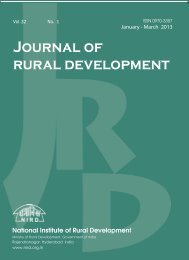October - December 2012 - National Institute of Rural Development
October - December 2012 - National Institute of Rural Development
October - December 2012 - National Institute of Rural Development
- No tags were found...
Create successful ePaper yourself
Turn your PDF publications into a flip-book with our unique Google optimized e-Paper software.
Regional Dimensions <strong>of</strong> Food Security in Maharashtra 475The reasons for declining foodavailability over time and the large variationsacross regions can be explained by examiningproductivity that in turn depends on variousexogenous and endogenous factors. To beginwith, trends in per capita foodgrainproduction across regions have beenestimated by taking into account the entirepopulation that includes all age groups (Figure2). 1 In the State, per capita foodgrainproduction is declining gradually from 1960to 2006 at varying rate over different phases.The declining per capita foodgrain productioncould be attributed to varying rate <strong>of</strong> growthin population over years. The rate <strong>of</strong> declinein the first phase till 1973-74 is relatively high,while it becomes visibly steep after 1973-74in subsequent phases, which could partly bedue to the adoption <strong>of</strong> new technology andpartly due to successful implementation <strong>of</strong>watershed programmes in Maharashtra whichhave had a significant impact on foodgrainproduction, as it was found that thecomparisons between beneficiaries and nonbeneficiarieshouseholds in watershed regionsin Maharashtra have shown significantlyhigher level <strong>of</strong> foodgrain production amongformer households as compared to that <strong>of</strong>latter (see Deshpande and Rajshekharan,1997). In the State, per capita foodgrainproduction has shown a large year to yearfluctuation across regions excepting theCoastal region, corresponding to the largevariations in rainfall, as large geographicalareas in the State fall under drought-proneconditions (Dev and Mungekar, 1996), andtherefore, are susceptible to vagaries <strong>of</strong>monsoon confronting phases <strong>of</strong> growth andstagnation affirmatively (Sawant et al, 1999).The visitation <strong>of</strong> droughts and famine overlarge parts <strong>of</strong> the State every three to fouryears indeed worsens the process (DHMJDrought Forum, 2008). Over the years, percapita foodgrain production has declined, i.e.,during 1973, 1987, 1992 and 2002, because<strong>of</strong> droughts during these years 9 . The Coastalregion <strong>of</strong> the State has had the lowest percapita foodgrain production over the periodas compared to other regions, whereasfoodgrain production has experiencedrelatively better trends in the Eastern region.The lowest per capita foodgrain productionin the Coastal region, despite the region’shigher productivity as compared to otherregions (Table 3), could be attributed to lowershare <strong>of</strong> land under cultivation. Share <strong>of</strong> bothNet Sown Area (NSA) and Gross CroppedArea (GCA) are lowest in the Coastal region,accounting for about 28 and 30 per cent inTE 2005-06, respectively (Table 4). On theother hand, the Eastern region, apredominantly rice producing area, has shownthe highest per capita foodgrain production,because <strong>of</strong> the high rainfall here, even thoughsoil fertility <strong>of</strong> the region is either mediumor low (Sawant et al, 1999, p-14) and lowpopulation growth in the region (see Table2). The higher output variability in foodgrainproduction in Nagpur division is explainabledue to high rainfall variability and/or lowirrigation facility (Mitra 1990, p-A 153).However, Nagpur division has two NSSOregions viz., Inland Eastern and Easternregions, and <strong>of</strong> the two, the latter region haslower output variability as compared to theformer region because the Eastern regioncomes under medium and high rainfall, lowervariation and medium soil fertility. The otherthree regions, namely, Inland Eastern, InlandWestern and Inland Northern regions areclose to each other in terms <strong>of</strong> per capitafoodgrain production, though, the soil fertilityand level <strong>of</strong> rainfall differ across theseregions. Deshpande (1988) examined therelation between growth and instability inMaharashtra and found varying relationshippre-new technology (1951-52 to 1971-72)and post-technology (1973-74 to 1981-82)period, drought prone (DP) and non-droughtprone (NDP) districts; and different group <strong>of</strong>crops. The major finding shows that thenegative and strong relation between growthJournal <strong>of</strong> <strong>Rural</strong> <strong>Development</strong>, Vol. 31, No. 4, <strong>October</strong> - <strong>December</strong> : <strong>2012</strong>

















